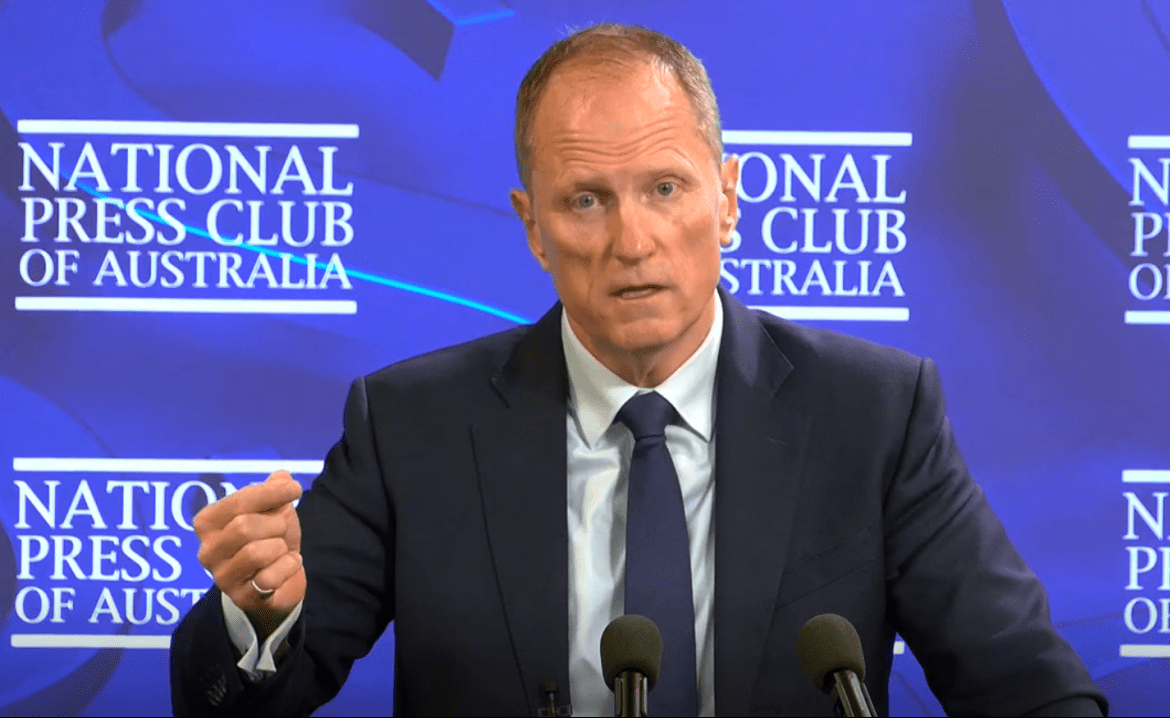
Andrew McConville addressed the National and Rural Press Clubs on Tuesday to mark the tenth anniversary of the Murray-Darling Basin Plan.
MURRAY-DARLING Basin Authority (MDBA) chief executive officer Andrew McConville said the wellbeing of farming communities need to be considered when measures are put forward to claw back the Basin plan’s water-recovery shortfall by the 2024 deadline.
The MDBA now estimates this gap to be 190-315 gigalitres (GL) under the water recovery target and it expects a significant shortfall to deliver an extra 450GL through efficiency measures.
On the tenth anniversary of the Murray Darling Basin Plan (MDBP), Mr McConville told the National and Rural Press Clubs that several projects under the Plan will not be completed by the 2024 deadline.
He said the MDBA expects that these projects, to be completed across several states, will deliver 290-415GL of the 605GL required under the plan.
“Put another way, we expect a shortfall of between 190 and 315 gigalitres,” Mr McConville said.
He said recovering another 450GL via “efficiency measures is also proving challenging”.
“Just over 4GL have been delivered, with a further 22.1GL contracted for delivery.
“[A]chieving 450GL by the 2024 deadline will be very difficult.”
It is noted that these recovery options must have a positive or no social or economic impact on Basin communities or irrigators.
“Some communities have lost out because of the Plan; others have thrived.
“Lessons from the various approaches to water recovery and their flow-on impacts to communities must be considered by government in future decisions.”
Role of irrigators
While acknowledging the current gaps in the MDBP’s performance, Mr McConville said the framework can boast many achievements as it reaches its tenth year.
He said a lot of these gains can be attributed to the actions of Basin irrigators and their collective desire to have sustainable agriculture and a “healthy river system”.
“Make no mistake, [irrigation-dependent communities] have done the heavy lifting, and on this 10-year anniversary of the plan, all Australians need to stop and think about that.”
Mr McConville praised Basin irrigators and said they have adapted well to drought and floods as well as the constraints of the MDBP.
“There’s been significant government investment to make every drop count, on and off farm – modern, clever irrigation networks, smart water meters and precision watering on-farm.
“A far cry from the Dethridge wheels of old!
“[T]he vasin’s irrigators, who are among the most innovative in the world, have been at the forefront of this transition.”
Possible water buybacks
Mr McConville refused to comment on whether water buybacks should be one of the possible new measures considered by Federal Minister for the Environment and Water Tanya Plibersek.
He said this would be government decision; however, communities shouldn’t be forgotten in the process.
“What we support…is a sustainable approach to water recovery, now the Minister has made it clear that all options are on the table and that includes purchasing water to do what is called bridge the gap.
“In any exercise to recover water…we have to be very cognisant of the impact water recovery is having on communities.
“Some have been positive and some have been negative and it is very important that we make sure we are taking into account the environment science, the social and economic science to understand the impacts on those communities.
“There is a range of options on the table, ultimately…it is a decision for governments on how they will recover that water, our job is to report transparently on the progress of that.”
Cooperation is key
With less than two years until the 2024 deadline, Mr McConville said all parties need to work together to get closer to reaching the water-recovery targets.
“Now more than ever, cooperation and commitment must be the cornerstone to our approach to adaptive water management in the Murray–Darling Basin.”
He said this must include cooperation between irrigators across the Basin and conservationists who are often at odds when debating key plan targets and options to reduce the recovery gaps.
“We need to ensure all interested parties have a seat at the table and are being heard, not just by governments and decision makers but by each other, because in my experience, that’s when we see transformative change.”
Developed in 2012, the MDBP initially set a benchmark target to recover 2750GL from community and agricultural uses and return it to the environment.
In 2018 as part of the Northern Basin Review, this was reduced to 2680GL.
This is separate to the additional 450GL water-recovery figure which will come solely from efficiency gains.
According to Mr McConville, of the 2680GL total, more than 2100GL has been returned to the environment.
The MDBP also includes input from Queensland, New South Wales, Victoria, South Australia and Australian Capital Territory governments and relevant local councils.
Grain Central: Get our free news straight to your inbox – Click here



HAVE YOUR SAY